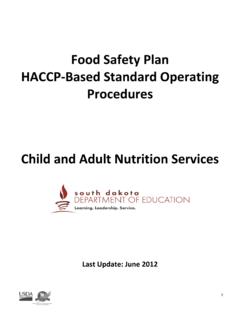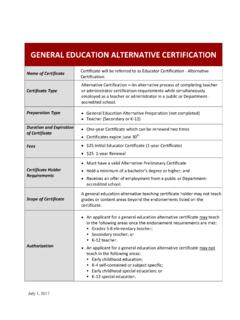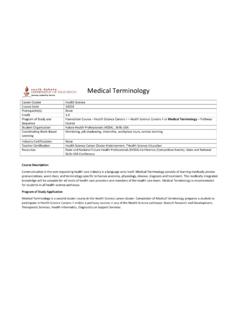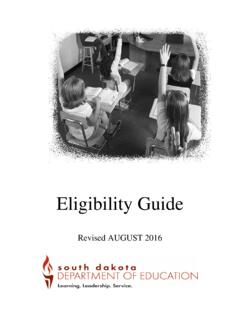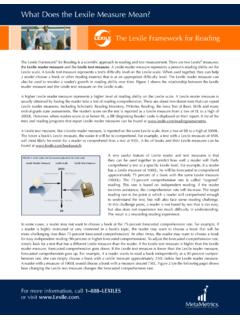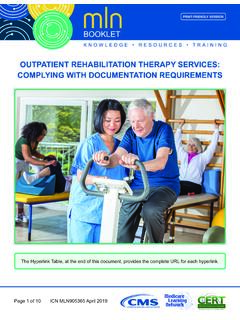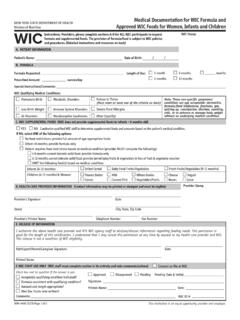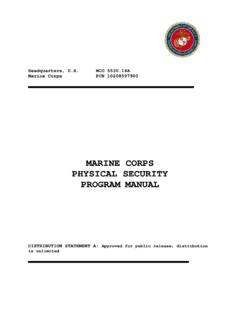Transcription of Prior Notice Examples - South Dakota
1 August 2013 IEP A Technical Assistance Guide Prior Notice Examples Meeting Notice ARSD 24:05:27:02. IEP team meeting date. Initial IEP team meetings must be held consistent with 24:05:25:03. IEP team meetings following reevaluations must be held consistent with 24:05:25:06. As soon as possible following development of the IEP, special education and related services are made available to the child in accordance with an IEP. ARSD 24:05:25:16. Parent participation. Each district shall take steps to ensure that one or both parents of the child are present at each IEP team meeting or are afforded the opportunity to participate. The district shall notify parents of the meeting early enough to ensure that they will have an opportunity to attend, scheduling the meeting at a mutually agreed-upon time and place.
2 The Notice to the parents shall state the purpose, time, and location of the IEP team meeting and who will be in attendance and inform the parents of the provisions relating to the participation of other individuals on the IEP team who have knowledge or special expertise about the child, including information related to the participation of the Part C service coordinator or other representatives of the Part C system at the initial IEP Team meeting for a child previously served under Part C of the IDEA. If a purpose of the IEP team meeting is the consideration of postsecondary goals and transition services for a student, the Notice must also address the provisions of 24:05:25 If parents cannot attend, the district shall use other methods to ensure participation, including individual or conference telephone calls consistent with 24:05:27 Meeting Notice This Notice is required Prior to scheduling a meeting.
3 Content of meeting Notice requires meeting date, time, location, purpose, attendees and contact information. Parental Prior Written Notice ARSD 24:05:30:04. Prior Notice . Written Notice which meets the requirements of 24:05:30:05 must be given to the parents five days before the district proposes or refuses to initiate or change the identification, evaluation, or educational placement of the child or the provision of a free appropriate public education to the child. The five-day Notice requirement may be waived by the parents. ARSD 24:05:30:05. Content of Notice . The Notice must include the following: (1) A description of the action proposed or refused by the district, an explanation of why the district proposes or refuses to take the action, and a description of any other options the IEP team considered and the reasons why those options were rejected; (2) A description of each evaluation procedure, assessment, record, or report that the district uses as a basis for the proposal or refusal; (3) A description of any other factors which are relevant to the district's proposal or refusal.
4 (4) A statement that the parents of a child with a disability have protection under the procedural safeguards of this article and, if this Notice is not an initial referral for evaluation, the means by which a copy of a description of the procedural safeguards can be obtained; and (5) Sources for parents to contact to obtain assistance in understanding the provisions of this article. August 2013 IEP A Technical Assistance Guide Parental Prior Written Notice : The Notice is required Prior to implementing any change in identification, evaluation, placement or the provision of FAPE, regardless of whether an IEP meeting was held or not. The Parental Prior Written Notice must clearly reflect a comprehensive overview of the proposal(s) agreed to and/or refused.
5 The Notice provides the parent/guardian a comprehensive overview of the changes and affords them time and opportunity to express additional questions and/or concerns, or seek resolution before any action is taken. example #1: (Student graduating) a. Explanation of why the district proposed or refused to take the action. (Student) is on track to graduate with a signed diploma. The IEP team met and developed a summary of performance that (student) will have for future use. He/she is scheduled to graduate on (date) at which time the district will no longer be responsible for (student s) educational program. b. Description of other options that the IEP team considered and the reasons why those options were rejected: The IEP team considered continuing services for (student).
6 After discussing the district s graduation requirements and (student s) current functioning, it was agreed that all requirements have been met, the mandatory number of credits received, and transition skills mastered. c. Description of each evaluation procedure, assessment record or report the district used as a basis for the proposed or refused action: The IEP team reviewed (student s) existing data to include the current status/progress on the IEP goals, transition services, activities, grades, transcripts and daily work. d. Description of other factors that are relevant to district s proposal or refusal: On (date) you were informed that all rights would transfer to (student) when (he/she) turns age 18 in the next two weeks.
7 We discussed at the meeting, as of (birthday) all rights will transfer. Special education notices will be provided to (student). They will continue to be provided to you as the parent as well. example #2: (Development of IEP following reevaluation) a. Explanation of why the district proposed or refused to take the action. Reevaluation data was reviewed and a new IEP with updated goals and target skills was developed. b. Description of other options that the IEP team considered and the reasons why those options were rejected: We discussed parent request of removing (student) from the math classroom to the resource room for the entire period rather than the current removal time of 15 minutes at the end of the math period. Due to the progress (student) is making in the current August 2013 IEP A Technical Assistance Guide placement, the district refused to place (student) in a more restrictive placement at this time.
8 C. Description of each evaluation procedure, assessment record or report the district used as a basis for the proposed or refused action: The IEP team reviewed all existing data to include current and previous evaluation reports, current grades, progress on annual goals, along with parent and teacher input, to develop (student s) current IEP. d. Description of other factors that are relevant to district s proposal or refusal: As new concepts in math are introduced, the general education teacher will review (student s) progress and call a team meeting if additional pull out time needs to be reconsidered. example #3 (Amendment meeting to change placement due to behavior) a. Explanation of why the district proposed or refused to take the action.
9 During (student s) amendment meeting held on (date) the team decided to change (student s) placement to a more restrictive environment until the (student s) behavioral data shows he/she is ready to return. Rather than his/her current placement of resource room, the team decided a residential placement would better meet his/her behavioral needs. b. Description of other options that the IEP team considered and the reasons why those options were rejected: The team considered providing all services in a self-contained classroom within the school setting, but the team agreed that due to (student s) emotional and behavioral needs the school does not have the expertise to provide the level of interventions, counseling, and behavior management techniques necessary to meet his/her educational needs.
10 C. Description of each evaluation procedure, assessment record or report the district used as a basis for the proposed or refused action: The primary basis for this change of placement is (student s) disruptive and self-destructive behaviors, which have increased in frequency and intensity within the school and home setting over the past 3 months. The increased counseling time, increased academic assistance in the resource room and the behavior plan have not been effective in teaching (student) appropriate techniques in dealing with his/her frustration. d. Description of other factors that are relevant to district s proposal or refusal: Until which time the placement to the residential placement is finalized, the district will provide services to (student) within the self-contained classroom.
